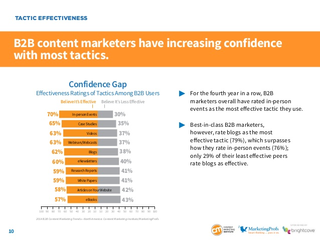
For better or for worse, most marketing tactics are now built upon content. In fact, according to the Content Marketing Institute’s 2015 B2B Content Marketing Trends & Benchmarks report, 70% of B2B marketers are creating more content than they did one year ago. According to the same CMI study, company blogs are one of the most effective marketing tactics, outpacing research reports, newsletters and white papers in terms of results realized.
Three of the top tactics (in-person events, webinars and video) require significantly more resources to deliver. Compared to these three tactics, blogging is relatively cheap and easy to produce; and as a bonus, it provides a nimble and consistent message platform. The reality, however, is that running an authentic blog is unquestionably a challenge. You need to cultivate contributors who can speak with authority to audience needs and interests, balancing the planned editorial calendar with flexibility to respond in real-time when opportunities present themselves.

(Source: CMI)
It’s tempting to simply outsource the blog to an agency and call it a day. However, before you go that direction, consider the potent effects quality blogs have on the top line; according to Hubspot’s State of Inbound 2014 report, marketers that have prioritized blogging in the marketing mix generate an ROI 13 times greater than those who don’t.
Why? Because blogs with authentic and useful voices drive qualified leads, closely pacing email marketing as a lead gen tactic according to the same Hubspot study.

(Source: Hubspot)
In doing the calculus of blog resourcing, it’s also useful to consider the benefits an authentic company blog can deliver to the organization, beyond the top line:
Internal Communication and Training
The blog may be external, but chances are good a lot of your employees are following it, meaning it becomes an important means of informing internal teams as well. A company blog that’s posting content that is aligned with key objectives reinforces key messages, product training, and positioning in a way that is relatable and also useful to internal audiences. By nature, most blog posts are written in a more relatable, informative voice, and provide real utility to customers, sales and client services teams. Furthermore, the “sticky” nature of well-written blog posts that are packed with tips, advice and anecdotes aids message retention and ultimately the adoption of key initiatives by internal teams.
Sales Enablement
Early on in my tenure running a blog for a B2B brand, I realized that I was having a conversation with my company’s sales team through my posts. The advice, trends, commentary and industry insights we doled out on the blog also had important utility for client facing teams, who used blog content in a variety of creative ways. Some of these ways included opening the doors to meetings, developing more personal visibility on LinkedIn and other social networks, delivering customer service and ongoing communications with clients and prospects. I pushed it further by answering tough questions the customer-facing teams heard in the field via blog posts, increasing the internal knowledge base while at the same time building credibility for the brand.
Thought Leadership
Today’s transparent digital environment makes it easy to distinguish between experts and posers. A quick Google search is a fast way to establish a purported expert’s bona fides.
A company blog is a great way to start building the digital pedigree of emerging brand experts, providing insight into their experience and point of view that build the experts’ reputations and are useful when drafting speaker proposals, pitching journalists and throughout the business development cycle.
From a brand perspective, blogs enable organizations to quickly comment upon industry events and trends, effectively positioning the brand as an authority while at the same time generating credible and relevant attention.
Prioritizing Quality and Utility
Whether or not the organization reaps these benefits from the blog, investment hinges ultimately upon the quality and the utility of the blog content. The aforementioned Hubspot survey noted that the highest ROI is achieved with content created by internal staff; which makes sense, given the relationship we would hope employees have with the marketplace. While effectiveness of outsourced content declined, content contributed by guests also showed improvement in results generated. The credibility and authority that brands derive from showcasing smart employees is invaluable in delivering return on the blogging investment and realizing a broad array of other benefits.
Kevin Anderson, the former blogs editor for The Guardian, summed it up best: “The bottom line is that blogging is like sex. You can’t fake it. You can’t fake passion. You can’t fake wanting to engage with the public. If you do, it will ultimately be an unsatisfying experience for both the blogger and their readers.”
(322)
Report Post




